Toward the end of 2024, we collected data from more than 4,500 people in a survey about men’s health. Erectile dysfunction was the second largest health concern our respondents experienced. We break down this data below.
In 2025, the number of people affected by ED is expected to reach 322 million*.
*data from the

Various studies have tried to estimate how common erectile dysfunction (ED) is. It may not be possible to find a concrete number, but surveys like ours can help us get an idea of
Our aim for this survey was to get an idea of our readers’ struggles and what brings them to our website. We asked our respondents about 19 different issues concerning men’s health.
Over a period of about 4 months, a total of 4,624 people responded to our men’s health survey questions. Of those respondents, 26% reported that they have issues with ED.
In this analysis of results, we’ll discuss the 26% and how they’ve been coping with and treating their ED, if at all.
For the purpose of this write-up, we broke down the questions we asked about ED into two specific question brackets:
- Discussing ED
- Medications for ED
We’ll discuss the relevance and importance of these topics below. Then, we’ll go into the numbers, analyze the responses, and discuss ideas for future research and surveys.
Discussing ED with a professional
The first bracket of questions asked the respondent about their experience discussing their ED with a healthcare professional. The first question asked whether the respondent had discussed their ED with a healthcare professional in the past 12 months.
Of those who reported that they had experienced ED, 37% of respondents said they had met with a healthcare professional online via telehealth, in person, or both in person and online.
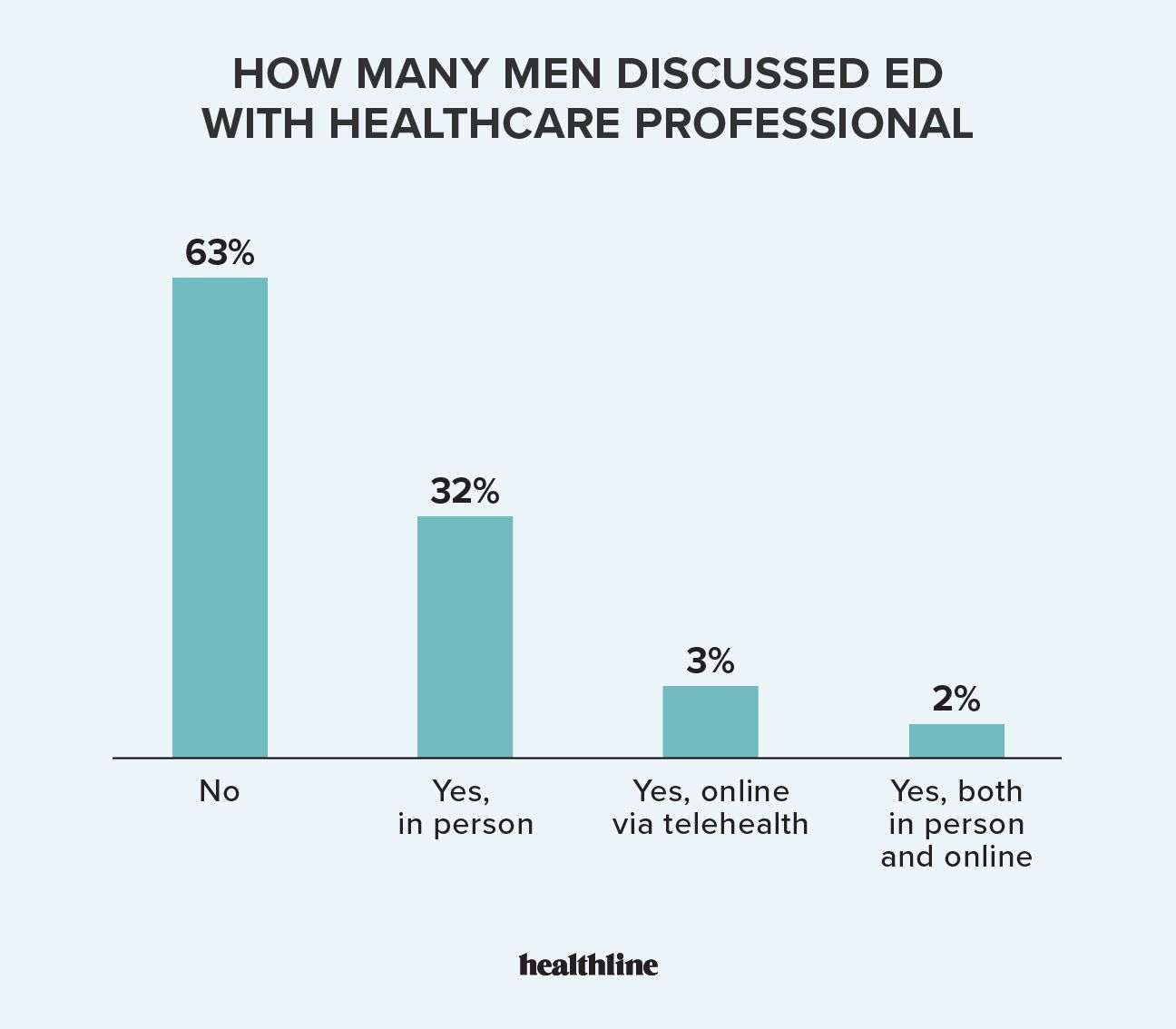
We narrowed it down even further and asked each person which telehealth platform they used and whether they used it for getting a prescription, speaking with a healthcare professional, or both.
These were the top responses and top telehealth platforms that respondents used.
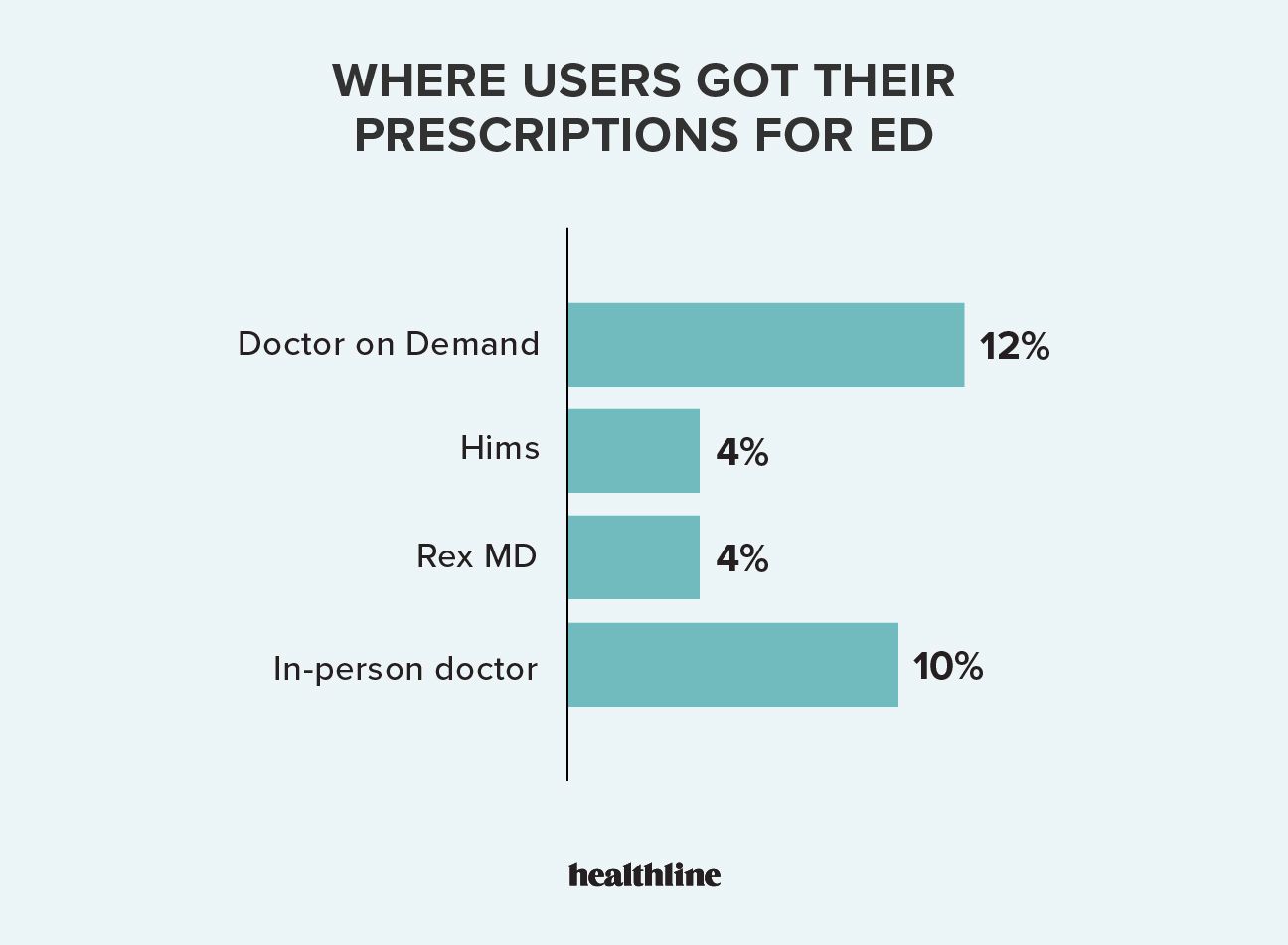
The other 63% of respondents did NOT meet with a healthcare professional. For these users, the next question we asked was “Why have you not discussed your erectile dysfunction with a healthcare professional in the last 12 months?”
The four most common reasons were:
- Not a top priority | 27%
- Uncomfortable discussing some of the
symptoms | 27% - Don’t believe there are any effective
treatments | 24% - Symptoms are not concerning
enough | 20%
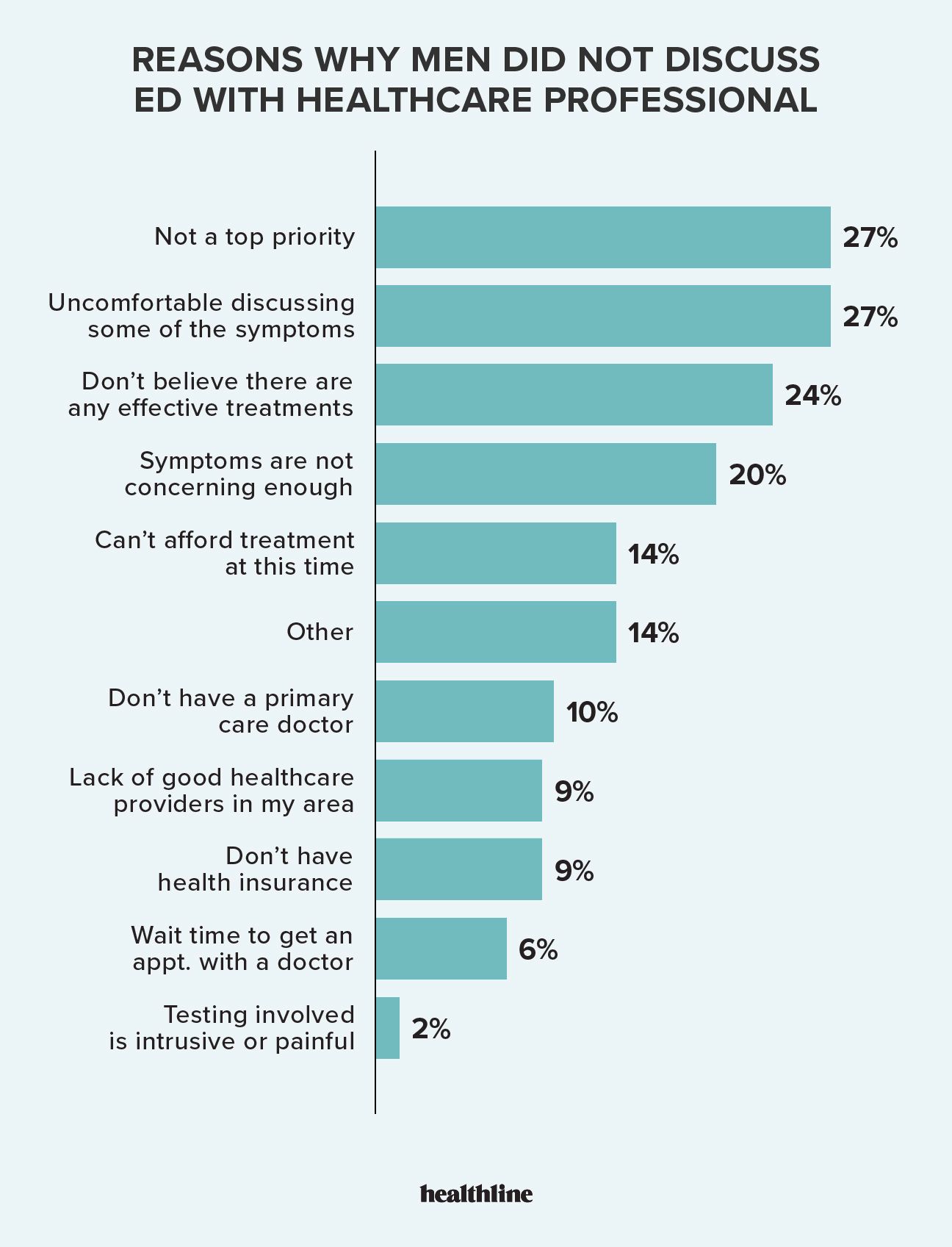
Medications for ED
The second bracket of questions we asked respondents had to do with medication and treatments for ED. We first asked which, if any, medications they were prescribed for their ED.
For those who were prescribed medications, the main types were:
- generic Viagra (sildenafil) | 22%
- generic Cialis (tadalafil) | 14%
- brand-name Viagra | 14%
- brand-name Cialis | 9%
The other prescription medications — Levitra, generic vardenafil, and Stendra — had very low numbers, so we could not use that data in this study write-up.
Of those who used either generic or brand-name Viagra or Cialis, we asked how effective the medication has been in treating their ED symptoms.
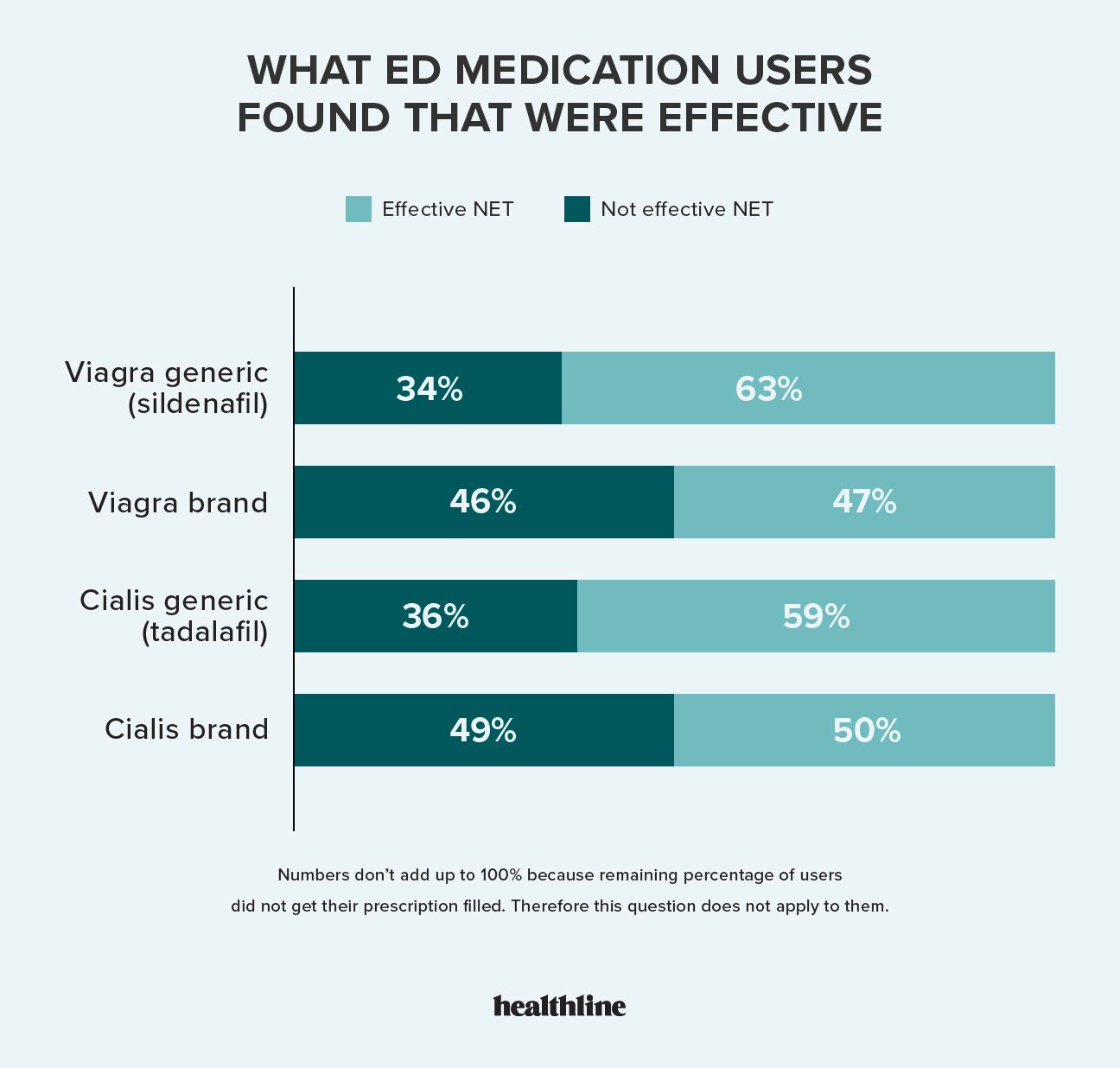
NOTE: The “NET” percentages combine two different responses based in the same category. For example, “Effective NET” consists of respondents who replied that they found their medication “somewhat effective” or “very effective.”
As previously discussed, most respondents who used an online telehealth platform used either Doctor on Demand (12%) or Hims (4%).
Of the respondents who used those two online telehealth platforms, 73% of respondents used Doctor on Demand to get medication and 80% used Hims.
All users who responded that they used an online telehealth platform were asked how easy it was to obtain the prescribed ED medications. This includes all telehealth platforms: Doctor on Demand, Hims, and the five other services listed.
We found that 85% of respondents believed it was very easy or somewhat easy to get a prescription for ED medications. Another 14% found it not easy at all or not very easy.
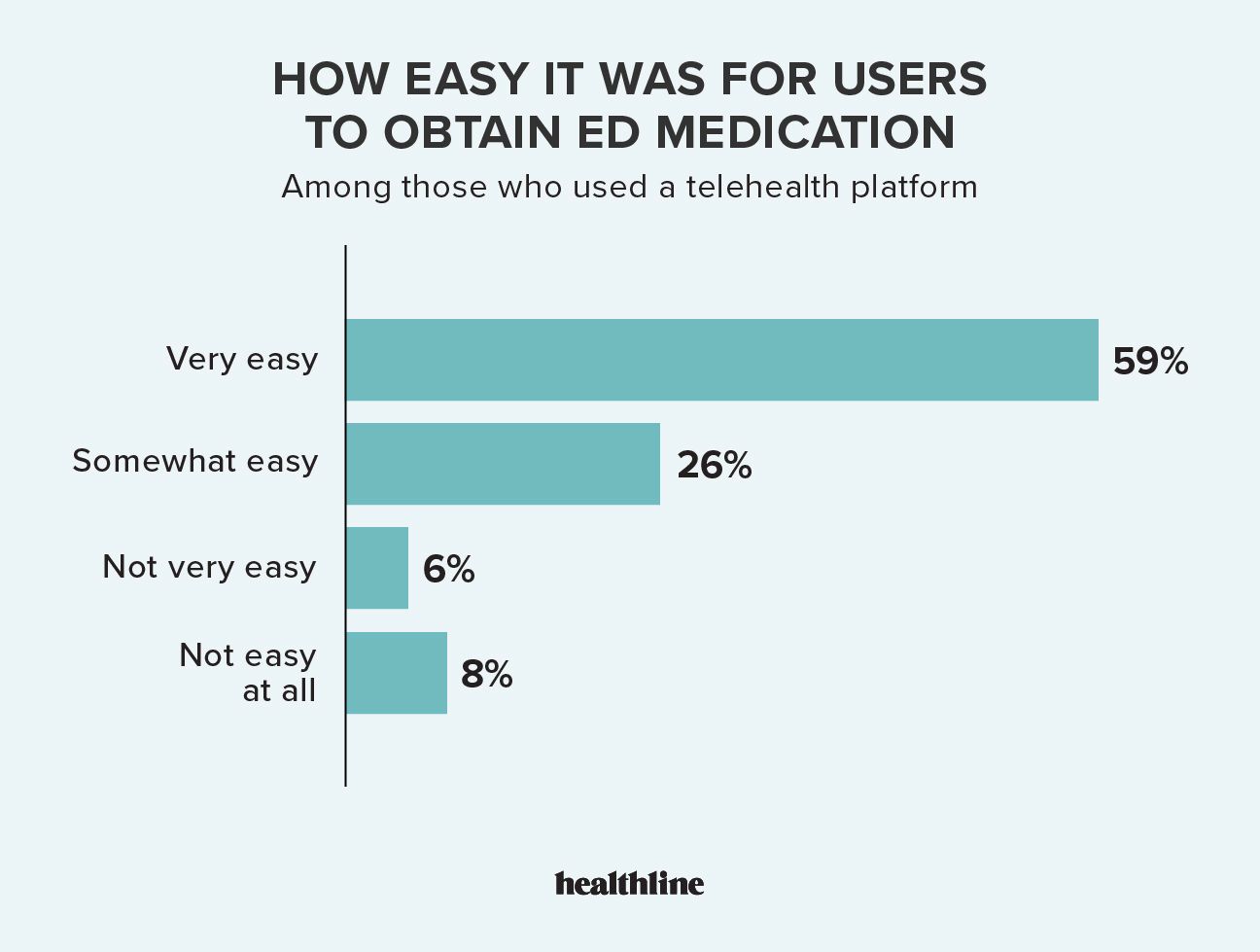
Discussing ED
Takeaway #1
63% of men feel uncomfortable speaking with healthcare professionals, friends, or family about their ED symptoms
When asked whether they had discussed their ED symptoms with a healthcare professional, 63% of respondents reported that they had not. Of the 63% of respondents who said no, 27% were uncomfortable discussing the symptoms with healthcare professionals, whether online or in person. And 24% of respondents said they didn’t believe there were any effective treatments for ED.
Another 27% didn’t believe their ED was a top priority to discuss, and 20% believed their symptoms were not concerning enough to discuss.
The users who responded that they didn’t share their ED symptoms with healthcare professionals also didn’t feel comfortable sharing their experience with friends or family.
A 2023 research review takes a look at ED through the lens of psychology. The authors suggest that men may feel a variety of psychological effects from sexual dysfunction, including feelings of being emasculated.
These researchers suggest that psychological treatment could help people with ED when medications and surgery may not be feasible for some, either financially or health-wise. How this would happen is still in the works, as the thought of treating ED with psychology is still largely unexplored and more research is necessary to determine its benefits.
In a future study, it would be interesting to explore the relationship of sex and the respondent. An older European study from 2006 shows that at least 83% of men and 63% of women from ages 40 to 80 describe sex as “extremely, very, or moderately” important to them.
For our research, it would be more telling if we asked respondents about their relationship to sex, how important it was, and their sexual identity and sexual orientation, as these may also play a role in experiencing ED and not wanting to seek treatment.
Takeaway #2
85% of people who used telehealth platforms for ED found them easy to use for prescriptions and for talking with a healthcare professional
Among users who have discussed their ED with a healthcare professional, 32% of them used a telehealth platform to do so. And of those users, 85% found that it was easy to get a prescription.
Telehealth has played a major role in society since the COVID-19 pandemic. For a topic that most men are not comfortable discussing with anyone, telehealth can take away some of the embarrassment or shame they might feel if they saw a doctor in person.
A research paper from 2022 delves into the stigma and reasons behind why discussions around ED can be taboo. Physician-related factors are one reason the authors mention: “Many physicians still avoid talking about sex/ED with their patients.”
The paper goes on to share that physician-related barriers can be overcome by methods such as “establish[ing] good patient rapport” and “be[ing] flexible and cognizant of the deeply seated values and beliefs of each patient.”
Each person’s experience in healthcare is different. Some have had the best experiences with any healthcare professional they’ve seen, and others have had nothing but the worst experiences.
This paper brings up a great point of how many respondents have had positive or negative experiences with healthcare professionals, and whether this is one of the reasons they may not actively seek care. It could be a great lens and insight into patient care and how people’s experiences have shaped their future care.
For any future research, we could consider asking users about their experience with the top platforms, which in this case were Doctor on Demand and Hims.
We could ask them about characteristics of the platforms and services that made them feel comfortable enough to open up, how their experience was when talking with a healthcare professional, the cost, and more.
Medications for ED
Takeaway #3
63% of users found the generic medication more effective than the brand-name version, even though the compounds are the same
Even though generic and brand-name PDE5 inhibitors contain the same compounds, users find the generic versions of the medications more effective.
This could have to do with the price of the medication.
Viagra, on average, can cost up to $90 per pill, whereas generic Viagra (sildenafil) can cost as little as $4 per pill on some telehealth sites, such as Hims. Users could be finding that the value of generic sildenafil is more than the value of brand-name Viagra. The only differences between the two are the price and the manufacturer.
This also identifies a gap in our research, where we could have asked respondents about their annual salary, their disposable income, and whether they had easy access to telehealth, specialists, and other healthcare professionals.
The data shows that at least 14% of respondents could not afford treatment for ED at the time of the survey. Another 10% did not have primary care doctors in their area, and 9% did not have access to good healthcare professionals. Also, 6% found that the wait time for a specialist was too long for them.
Looking deeper into this disparity is a focal point we would love to consider in any future explorations.
Points for further discussion
Why do respondents with ED not want to 1) discuss symptoms, 2) seek treatment, and 3) take medication?
In a 2013 study that included 186 men who took PDE5 inhibitors for ED, one-third of the participants stopped taking the pills after 1 prescription, and one-half stopped taking them after 6 months of continued use.
The authors of a 2023 study suggest that the psychological aspects of ED are not often considered, so the pills may not have any effect because the right area is not being targeted.
There are also very serious risks and drug interactions between heart medications, heart conditions, and ED medications.
Usually, either in person or through telehealth, a healthcare professional will ask questions about a person’s health history, whether they are taking any medications, and whether they have any heart conditions or history of heart conditions. Because of these risks, folks who have these conditions or take these medications will not qualify for ED medications.
And some folks may not seek out other options because they don’t know that there are alternative treatments for ED.
There are other options, such as penile prosthesis implantation, that could be more effective for those who cannot take PDE5 inhibitors because of a health condition or because the PDE5 inhibitors did not work for them. However, if previous treatments have not worked and respondents do not consider ED a priority, they may not be interested in other forms of treatment.
All these observations and more could be reasons why some respondents choose not to take medication for their ED. Their lack of comfort with seeking help may allude to the idea that the societal construct of masculinity could be affecting men’s psychology and any physical, emotional, or psychological challenges men may face.
Taking care of oneself has become a focal point in our society over the past few years. However, it is seldom tailored to men’s emotional and psychological health. Sexual intimacy has been shown to be an important part of some relationships, and problems such as ED can cause psychological harm to both the person experiencing ED and their partner.
The long-term effects of ED can lead to a greater decline in psychological, social, and physical well-being. But men may not consider these issues important enough to treat, just as some men do not consider ED important enough for treatment.
The societal constructs of masculinity do add an extra layer that industries need to break through and consider as they’re trying to reach the consumer. In future research, it would be interesting to delve into the societal norms and upbringing of the respondents and how that could affect their need or denial for treatment.
Our responses were reported by the Qualtrics XM Platform. It helped us reach our audiences across Healthline’s men’s health articles. The data reported shows specifically the findings of the users with ED. Note that due to privacy laws, Connecticut, Nevada, and Washington state were excluded from the survey.
We specifically looked for readers who were visiting pages on any of the following topics:
- hair loss
- aging
- sexual health
- fatherhood
- sex and intimacy
- low testosterone
- testosterone
- male infertility
- men’s mental health
- parenthood or parenting
- male cancers
- generic health
- male sexual health
- male surgeries
- penile cancer
- physical health
- prostate health
- prostate care
- prostate cancer
- sexual health
After building out our question list and brackets, our Consumer and Market Insights team sent out the survey and collected responses for about 4 months. In that time, we collected 4,624 answers from men of various ages and backgrounds who experience ED.
Most respondents who identified with ED were white males over 61 years old. The second most identified age group was 51 to 60 years.
However, we did not ask the respondents to specify their sex or gender identity in this survey.
NOTE: The remaining respondents in the “Race and Ethnicity” infographic chose not to specify their ethnicity.
If we were able to, we would like to increase the length of time for collecting responses so we could allow for more responses from people of more ethnicities and a wider age range.
Confirming and solidifying the gender and sex of our respondents would make our results more transparent and accurate. Sexuality and gender would be another lens from which to look at ED data.
It would also be interesting to delve into individuals’ health problems so we could potentially make the connection of why some men are not taking ED medications. Delving into psychological issues or diagnoses could give us insight on men’s mental health and how it relates to their ED, if at all.
We would also ask whether our respondents would be willing to try alternative treatments if they knew the success rate and if the cost was manageable, since 14% of those who had not discussed their ED said they did so because they could not afford treatment.
An analysis strictly by age would be very insightful and exciting to look at to compare age, willingness for treatment, effectiveness of medication, and more. We are currently working with Suzy, a survey website, to further this data.



